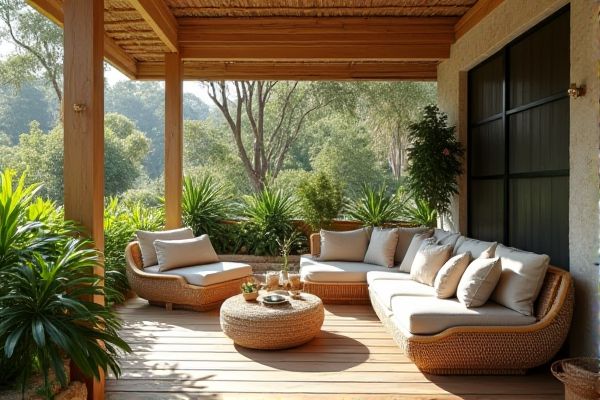
Synthetic rattan offers superior durability and weather resistance for terrace furniture, making it ideal for outdoor use without the need for frequent maintenance. Explore the rest of the article to discover which rattan type best suits your terrace needs.
Table of Comparison
| Feature | Synthetic Rattan | Natural Rattan |
|---|---|---|
| Material | Polyethylene (PE) or resin-based fibers | Natural vine from rattan palm |
| Durability | Weather-resistant, UV-resistant, waterproof | Less durable, prone to moisture damage and cracking |
| Maintenance | Low maintenance, easy to clean | Requires regular cleaning and treatment |
| Appearance | Uniform, modern look with various colors | Natural, rustic appearance with unique texture |
| Cost | Moderate to high | Generally lower but varies by quality |
| Environmental Impact | Non-biodegradable but recyclable | Biodegradable and renewable resource |
| Suitability for Terrace | Ideal for outdoor terraces due to weather resistance | Better suited for covered or shaded terraces |
Introduction to Rattan Materials for Terraces
Synthetic rattan offers enhanced durability and weather resistance, making it an ideal choice for terrace furniture exposed to elements. Natural rattan provides authentic texture and eco-friendly appeal but requires regular maintenance to withstand outdoor conditions. Your terrace can benefit from selecting synthetic rattan for longevity or natural rattan for its natural aesthetic.
What is Synthetic Rattan?
Synthetic rattan is a durable outdoor furniture material made from polyethylene fibers that mimic the look and texture of natural rattan while providing superior resistance to moisture, UV rays, and weather conditions. Unlike natural rattan, which is harvested from tropical climbing palms, synthetic rattan maintains its color and flexibility without cracking or fading, making it ideal for terraces exposed to varying climates. Your terrace furniture crafted from synthetic rattan offers low maintenance and long-lasting beauty, combining aesthetic appeal with practical outdoor performance.
What is Natural Rattan?
Natural rattan is a climbing palm native to tropical regions, known for its sturdy, flexible stems used in crafting outdoor furniture and decor. It offers an authentic, breathable texture ideal for terraces, blending durability with a natural aesthetic. Your choice of natural rattan ensures eco-friendly, biodegradable materials that age gracefully in outdoor environments.
Durability and Longevity Comparison
Synthetic rattan offers superior durability and resistance to harsh weather conditions, making it ideal for terrace furniture that faces sun, rain, and humidity. Natural rattan, while aesthetically pleasing and eco-friendly, tends to degrade faster due to its susceptibility to moisture, mold, and UV damage. Choosing synthetic rattan ensures your outdoor furniture maintains its appearance and structural integrity for years with minimal maintenance.
Weather Resistance: Synthetic vs Natural Rattan
Synthetic rattan offers superior weather resistance compared to natural rattan, as it is made from polyethylene or resin materials designed to withstand UV rays, rain, and humidity without fading or cracking. Natural rattan, derived from palm plants, is susceptible to moisture damage, mold growth, and sun deterioration, making it less durable for outdoor terrace use. For long-lasting terrace furniture that maintains its appearance and structural integrity, synthetic rattan is the preferred choice in harsh weather conditions.
Maintenance Requirements for Terrace Furniture
Synthetic rattan terrace furniture demands minimal maintenance, requiring only occasional cleaning with mild soap and water to resist fading and weather damage. Natural rattan furniture requires regular sealing or varnishing to protect against moisture, UV rays, and pests, making it more labor-intensive. Choosing synthetic rattan reduces upkeep time and prolongs the furniture's lifespan in outdoor terrace settings.
Aesthetic Appeal and Design Options
Synthetic rattan offers a consistent color and texture, allowing for a wide range of design options and vibrant finishes that resist fading in outdoor terrace settings. Natural rattan provides a warm, organic aesthetic with unique, irregular patterns that enhance the natural charm of terrace furniture but requires more maintenance to preserve its appearance. Both materials cater to different style preferences, with synthetic rattan suiting modern, sleek designs and natural rattan embodying rustic, traditional elegance.
Environmental Impact and Sustainability
Synthetic rattan, made from polyethylene or other plastics, generally has a higher environmental footprint due to fossil fuel extraction and limited biodegradability, whereas natural rattan is a renewable resource that biodegrades and supports forest ecosystems. Harvesting natural rattan promotes sustainable forestry when managed responsibly, but overharvesting can lead to deforestation and habitat loss. Choosing natural rattan sourced from certified sustainable plantations reduces ecological impact, while synthetic rattan offers durability and weather resistance but contributes to microplastic pollution over time.
Price Differences and Value for Money
Synthetic rattan for terraces typically costs 20-40% more upfront than natural rattan due to its enhanced weather resistance and durability. While natural rattan offers a lower initial price, it requires more frequent maintenance and replacement over time, impacting long-term value. Investing in synthetic rattan provides better value for money by minimizing upkeep costs and extending furniture lifespan in outdoor settings.
Best Choice for Your Terrace: Synthetic or Natural Rattan?
Synthetic rattan offers superior durability and weather resistance, making it ideal for terraces exposed to rain, UV rays, and temperature fluctuations. Natural rattan provides an authentic, classic aesthetic with eco-friendly qualities but requires regular maintenance to prevent damage from moisture and sun exposure. For low-maintenance, long-lasting terrace furniture, synthetic rattan is the best choice, while natural rattan suits covered or sheltered outdoor spaces where style is prioritized over durability.
 homyna.com
homyna.com